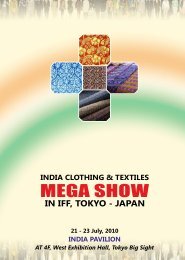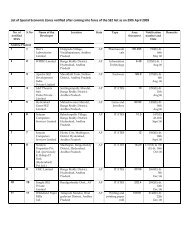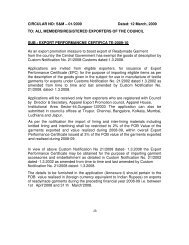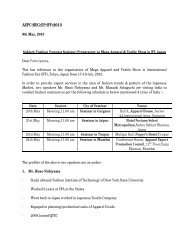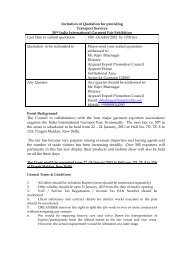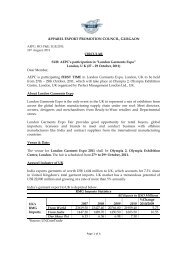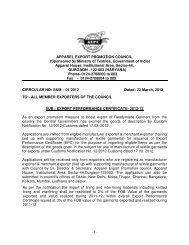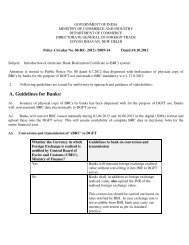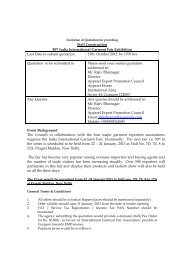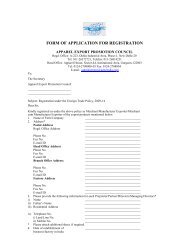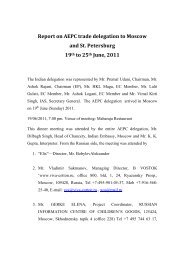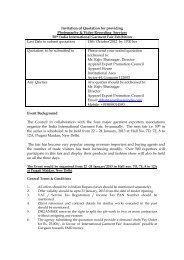apparelindia - Apparel Export Promotion Council
apparelindia - Apparel Export Promotion Council
apparelindia - Apparel Export Promotion Council
Create successful ePaper yourself
Turn your PDF publications into a flip-book with our unique Google optimized e-Paper software.
AEPC Initiatives<br />
AEPC Chairman sends proposal to Commerce<br />
Secretary for boosting garment exports from India<br />
Proposes measures to enhance 100% garment exports in 3 years, and 10% within 2012-13<br />
Dr. A Sakthivel, Chairman AEPC, on behalf of the garments and textiles exporters submitted the proposal to Shri S. R. Rao,<br />
Commerce Secretary in the Department of Commerce, Government of India. Speaking on the proposal, Chairman AEPC said that,<br />
“We have learnt that Ministry of Commerce/Ministry of Textiles is likely to announce certain sops to the garment industry in order to<br />
face challenges on global slowdown. I am providing herewith further details of my proposal”<br />
Proposal 1<br />
Cotton yarn be permitted imports without license at flat fixed customs duty rate, equivalent to all industry rate of duty drawback. <strong>Export</strong>s of<br />
finished product made from such imported yarn be allowed at corresponding rate of duty drawback. For example, import of cotton yarn be<br />
allowed at flat 3% rate (rate of duty drawback) or dyed cotton yarn be allowed at flat rate of 3.5% (rate of duty drawback). <strong>Export</strong>s of garments<br />
made from such cotton yarn be allowed at drawback of 7.9% on FOB (rate of duty drawback).<br />
Proposal 2<br />
Fabrics be permitted imports without license at flat fixed customs duty rate, equivalent to all industry rate of duty drawback. <strong>Export</strong>s of finished<br />
product made from such imported fabrics be allowed at corresponding rate of duty drawback. For example, import of cotton fabrics be allowed at<br />
flat rate of 4.5% (rate of duty drawback). <strong>Export</strong>s of garments made from such cotton fabrics be allowed at drawback of 7.9% on FOB(rate of<br />
duty drawback). On the issue of price stability in cotton yarn and fabrics, Chairman AEPC proposed that the import of cotton yarns and fabrics at<br />
fixed customs duty, equivalent to rate of drawback rate, may also be permitted and drawback may be allowed on export of readymade garments<br />
manufactured from such imported cotton yarn/fabrics at pre-determined drawback rates, he added.<br />
Dr. Sakthivel further proposed that, In order to protect the interest of the Government, garment exporters, member of AEPC may be permitted<br />
imports of yarn/fabrics maximum to the extent of 25% of their export performance in the preceding year.<br />
The countries, which have attained good growth in garments are<br />
listed below:<br />
Country 2005 (<strong>Export</strong>s) US$ 2012 (<strong>Export</strong>s) US$ growth%<br />
Bangladesh 3 Bn 20 Bn 566.67%<br />
Vietnam Almost negligible 12 Bn Infinity<br />
Cambodia Almost negligible 6 Bn Infinity<br />
India 5 Bn Approx 13.5 Bn 170%<br />
Bangladesh, Vietnam and Cambodia do not have raw material of<br />
their own and they have achieved phenomenal growth through easy<br />
import policy of yarn and fabrics. The current scheme of advance<br />
license in the Foreign Trade Policy of our country, although allows<br />
duty free import but it is a tedious route and is not used extensively<br />
by the exporters. Under the proposal, new fabrics / yarns, which<br />
are not produced in India will also get manufactured and in times<br />
to come even these yarns / fabrics will be produced indigenously<br />
substituting imports.”<br />
“Under this proposal, the procedural hurdles which are faced by<br />
SMEs in obtaining and closing advance licensing route for the imports<br />
would automatically get solved at one hand and on the other hand the<br />
imports for export manufacturing would be subjected to import duty<br />
(nil in the case of advance licensing scheme). This proposal would<br />
automatically lead to grant of full duty drawback at the time of value<br />
added exports in the shape of garments since inputs in the shape of<br />
yarn / fabric are subjected to payment of customs duty.”<br />
Chairman AEPC commented that “Under the proposed measure,<br />
it is projected that the garment exports would grow at 10% in the<br />
balance period of 2012-13 and would also grow phenomenally by<br />
100% in next 3 years with this scheme in operation. It is requested<br />
that proposal as requested above may be considered, in the interest<br />
of export promotion so that the garment export industry continues<br />
to give employment to 11.22 million workers, besides generating<br />
precious foreign exchange for the country. This would greatly help in<br />
reducing our trade deficit.”<br />
10 APPAREL INDIA



